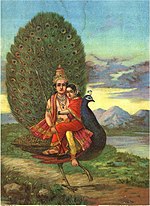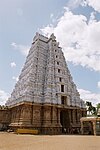
The Srikalahasti Temple is located in the town of Srikalahasti, in Tirupati district in the state of Andhra Pradesh, India. According to regional tradition, it is said to be the site where Kannappa was ready to offer both his eyes to cover blood flowing from the linga before Shiva stopped him and granted him moksha. The inner temple was constructed around the 5th century and the outer temple was constructed in the 11th century by the Rajendra Chola I and other Chola emperors such as Rajaditya Chola, Rajaraja Chola I, Rajadhiraja Chola I, Kulottunga Chola I, Kulottunga Chola III and the Vijayanagara kings especially Krishnadevaraya. Shiva in his aspect as Vayu is worshipped as Kalahasteeswara. The temple is also regarded as Rahu-Ketu kshetra and Dakshina Kailasam.

The Pataleshwar Caves, also referred to as the Panchaleshvara temple or Bhamburde Pandav cave temple, are an 8th-century rock-cut Hindu temple from the Rashtrakuta period located in Pune, Maharashtra, India. Dedicated to Shiva, it was a monumental monolithic excavation with a notable circular Nandi mandapa and a large pillared mandapa. It is a temple of three rock-cut cave sanctums, likely dedicated to Brahma-Shiva-Vishnu originally, but currently to Parvati-original Shiva-Ganesha. A garden now surrounds the site, new idols have been placed elsewhere in the complex. The interior of the caves have suffered damage from vandalism. Outside, the monument shows the effects of natural elements over the centuries.

The Subramaniya Swamy Temple, Tiruchendur is an ancient Hindu temple dedicated to Murugan (Kartikeya). It is second among six abodes of Murugan situated in Tamil Nadu, India. It is located in the eastern end of the town Tiruchendur in the district of Thoothukudi, Tamil Nadu, India. It is 40 km from Thoothukudi, 60 km south-east of Tirunelveli and 75 km north-east of Kanyakumari. The temple complex is on the shores of Bay of Bengal.

The Subramaniya Swamy Temple, Marudhamalai, or the Marudhamalai Murugan Temple, is a popular 12th-century hill temple situated in Coimbatore, Tamil Nadu, India. Built by Tamil kings during the Sangam period as indicated in the Purananuru, the temple is dedicated to Lord Murugan and is considered the Seventh House of Lord Murugan.

Vaḷḷi is a Hindu goddess, and the second consort of the deity Murugan. An incarnation of the goddess Sundaravalli, daughter of Vishnu, Valli is born on earth as the daughter of a chieftain, leading a life of a huntress. Murugan, the god of war, eventually woos and weds her, according to Tamil folklore. Both of their legends originate from the mountain region also known as Kurunji in Tamilakam. Her sister, Amritavalli (Devasena), also succeeds in marrying Murugan as the adopted daughter of Indra, making them sister-wives.
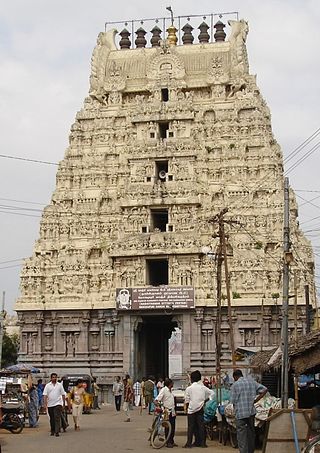
The Sri Kamakshi Amman Temple is an ancient Hindu Temple dedicated to the goddess Kamakshi, one of the highest aspects of Adi Parashakti, the mighty goddess in Shaktism. The temple is located in the historic city of Kanchipuram, near Chennai, India. The temple houses one of the 108 Divya Desams of Vishnu and is called Tirukalavanur. The temple is dedicated mainly to Kamakshi and then to Vishnu in his form of Varaha. The temple is glorified by the 6th-9th century Vaishnavite Alvars in the Naalayira Divya Prabandham. Its construction is credited to the Pallava kings, whose capital was in the same city. This temple, along with the goddesses of Madurai and either Varanasi or Thiruvanaikovil, are the important centers of Shaktism in the state of Tamil Nadu. The present temple is also known as Kamakoti Peetha or Kamakota Nayaki Kovil, where Tripura Sundari had settled after killing a demon. This ancient temple was mentioned in Perunaraatrupadai, an ancient Tamil literature that praises the renowned Sangam era. King Thondaiman Ilandiraiyan of the Pallava dynasty, who ruled Kanchipuram, constructed the temple. Kamakshi is worshipped in the shrine in 5 forms, one of them was a golden idol, which was transported to Thanjavur due to the Muslim invasions of Kanchipuram. There are no other goddess temples in the city of Kanchipuram, apart from this one, which is unusual in a city that has hundreds of traditional temples. There are various legends that account for this fact.
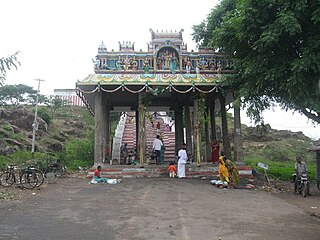
Kundrathur is a town located in the Chennai Metropolitan Area and the headquarters of Kundrathur taluk in Kanchipuram District. It is the birthplace of Sekkizhar, a well-known poet-saint who authored the Periyapuranam.
Padi is a locality and neighbourhood in the city of Chennai, India. It was named as Thiruvaaipadi and Later called as Padi short form of Thiruvaaipadi, Sundarar, came to Padi and sang songs in the Lord Shiva Temple. Padi exactly 13 km from the city's Kilometer Zero is a latest included part of the city. MTH Road, now unofficially known as the CTH Road, passes through Padi. Padi is basically an industrial area and its infrastructure and living conditions have made this place popular among the working class. Arulmigu Thiruvalithayam Temple in Padi is one of the famous Guru Bhagawan temples in Chennai. This temple is under the control of Hindu Aranilayathurai. Every year Thai Kirthigai is one of the big festival in Padi. Another nearby temple is the Padavattamman Temple.

Arulmigu Murugan Temple, Thiruparankundram is a Hindu temple dedicated to the god Murugan at Thiruparankundram, Tamilnadu, India. It is regarded as one of the "First Houses of Murugan". The temple uses rock-cut architecture and is believed to have been built by the Pandyas during the 6th century. According to legend, Murugan slayed the demon Surapadman and married his consort Devasena at the temple. Murugan is also said to have worshipped his father Shiva at the site as Parangirinathar.

The Subramaniya Swamy Temple is a Hindu temple, on the hill of Tiruttani, Tiruvallur district, Tamil Nadu, India, dedicated to Murugan. The hill has 365 steps indicating 365 days of the year. It is fifth among the six abodes of Murugan The other five are Palani Murugan Temple, Swamimalai Murugan Temple, Thiruchendur Murugan Temple, Thiruparankundram and Pazhamudircholai Murugan Temple. Tiruttani is 87 kilometres (54 mi) from Chennai. It is the only adobe located within the Greater Chennai Metropolitan Area limit. During the Sangam era, Tiruttani was known as Kundruthoradal. After killing the asura Tarakasura in Tiruchendur, he came here to subside his anger, so Surasamharam is not conducted here.
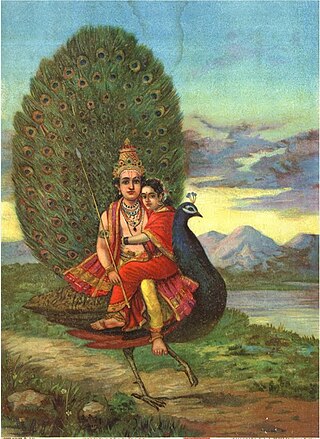
Devasena is a Hindu goddess of aspiration, and the consort of the war god Kartikeya (Murugan). She is also known as Devayanai, Deivanai, and Deivayanai in Tamil texts. Her name is also spelled as Teyvanai or Tevayanai.
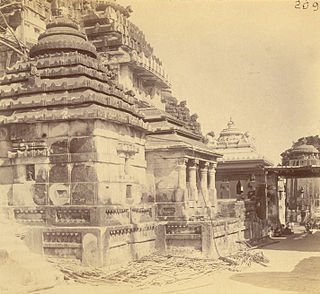
The Vimala Temple or Bimala Temple is a Hindu temple dedicated to goddess Vimala or Bimala (ବିମଳା), located within the Jagannath Temple complex in Puri in the Indian state of Odisha. It is generally regarded as a Shakti Pitha, among the holiest temples dedicated to the Hindu Goddess.
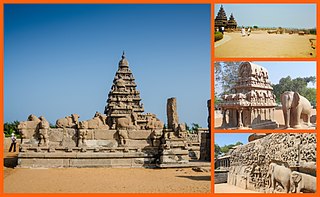
The Group of Monuments at Mahabalipuram is a collection of 7th- and 8th-century CE religious monuments in the coastal resort town of Mahabalipuram, Tamil Nadu, India and is a UNESCO World Heritage Site. It is on the Coromandel Coast of the Bay of Bengal, about 60 kilometres (37 mi) south of Chennai.

Mahishasuramardhini Mandapa is an example of Indian rock-cut architecture dating from the late 7th century, of the Pallava dynasty. It is a rock-cut cave temple located on a hill, near a lighthouse, along with other caves in Mamallapuram. Mamallapuram, also popularly known as Mahabalipuram, is a small village to the south of Chennai, in the state of Tamil Nadu, India. The temple is part of the Group of Monuments at Mahabalipuram, a UNESCO World Heritage Site inscribed in 1984. This Cave Temple has many interesting architectural features of which three exquisitely carved reliefs on the cave walls of three sanctums are prominent. One is of Vishnu reclining on the seven hooded serpent, Adishesha, another of Durga, the main deity of the cave temple Durga slaying the buffalo headed demon Mahishasura, and the third sanctum has a sculpture of Shiva.

Pachaimalai Arulmigu Subramanya Swamy Temple, also known as the Pachaimalai Balamurugan Temple, is one of the two major hill temples located in Gobichettipalayam, Tamil Nadu, India. The temple is dedicated to the Lord Murugan. The temple is constructed in the Tamil style of architecture and is located on top of a small hillock in the outskirts of the town of Gobichettipalayam near Pudupalayam, Tamil Nadu. Here, Kartikeya is venerated as Balamurugan or Subramanya Swamy.

The Mogalrajapuram Caves are five rock-cut cave temple groups located in different parts of Vijayawada, Andhra Pradesh, India. Dedicated to Shiva, they were excavated during the Eastern Chalukya reign or the Vishnukundins reign. They are generally dated to about the 7th century, after the Akkanna Madanna Caves. They are simple and small, yet the artwork and iconography is more sophisticated than Akkanna Madanna Caves. These include Nataraja, Ganesh and Ardhanarisvara. They are generally numbered as Cave I through V, with Mogalrajapuram Cave II being the most architecturally and iconographically evolved of the five.

Mamandur is a village in Tiruvanamalai district of Tamil Nadu, India. It is located on the Kanchipuram - Vandavasi road, near Dusi and about 10 km from Kanchipuram. It is known for the 7th-century rock-cut cave temple, housing a Tamil Brahmi inscription, one of the monuments of national importance as declared by the Archaeological Survey of India.

Ukanthamalai Murugan Kovil is the well known ancient Hindu temple situated in the Okanda, Ampara District of Eastern Sri Lanka, about 145 km south of Batticaloa town. This alluring temple dedicated to Lord Murugan in the heart of Kumana forest is a main stand for the devotees performing pilgrimage to Katirkamam through dense jungle. In places like Pânama and Kumana, which are close to Ukantai, Tamils and Sinhalese lived in harmony even down to the present day.

Ninra Narayana Perumal Temple or Thiruthankaal in Thiruthangal, a town in the outskirts of Sivakasi in the South Indian state of Tamil Nadu, is dedicated to the Hindu god Vishnu. Constructed in the Dravidian style of architecture, the temple is glorified in the Divya Prabandha, the early medieval Tamil canon of the Alvar saints from the 6th–9th centuries AD. It is one of the 108 Divya Desam dedicated to Vishnu, who is worshipped as Ninra Narayana and his consort Lakshmi as Arunakamala Mahadevi.

Kanthaswamy Temple in Cheyyur, in Chengalpattu district in the South Indian state of Tamil Nadu, is dedicated to the Hindu god Murugan. Constructed in the Dravidian style of architecture, the temple was constructed during the Cholas during the 10th century. Murugan is worshipped as Kanthaswamy along with his consorts Valli and Deivasena. A granite wall surrounds the temple, enclosing all its shrines.
